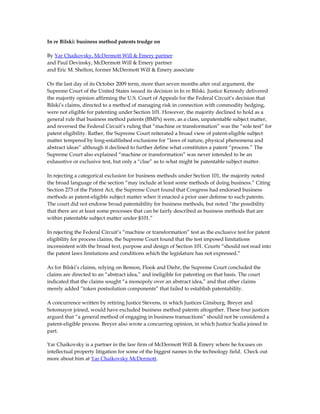
Yar Chaikovsky McDermott business method patents trudge on
- 1. In re Bilski: business method patents trudge on By Yar Chaikovsky, McDermott Will & Emery partner and Paul Devinsky, McDermott Will & Emery partner and Eric M. Shelton, former McDermott Will & Emery associate On the last day of its October 2009 term, more than seven months after oral argument, the Supreme Court of the United States issued its decision in In re Bilski. Justice Kennedy delivered the majority opinion affirming the U.S. Court of Appeals for the Federal Circuit’s decision that Bilski’s claims, directed to a method of managing risk in connection with commodity hedging, were not eligible for patenting under Section 101. However, the majority declined to hold as a general rule that business method patents (BMPs) were, as a class, unpatentable subject matter, and reversed the Federal Circuit’s ruling that “machine or transformation” was the “sole test” for patent eligibility. Rather, the Supreme Court reiterated a broad view of patent-eligible subject matter tempered by long-established exclusions for “laws of nature, physical phenomena and abstract ideas” although it declined to further define what constitutes a patent “process.” The Supreme Court also explained “machine or transformation” was never intended to be an exhaustive or exclusive test, but only a “clue” as to what might be patentable subject matter. In rejecting a categorical exclusion for business methods under Section 101, the majority noted the broad language of the section “may include at least some methods of doing business.” Citing Section 273 of the Patent Act, the Supreme Court found that Congress had endorsed business methods as patent-eligible subject matter when it enacted a prior user defense to such patents. The court did not endorse broad patentability for business methods, but noted “the possibility that there are at least some processes that can be fairly described as business methods that are within patentable subject matter under §101.” In rejecting the Federal Circuit’s “machine or transformation” test as the exclusive test for patent eligibility for process claims, the Supreme Court found that the test imposed limitations inconsistent with the broad text, purpose and design of Section 101. Courts “should not read into the patent laws limitations and conditions which the legislature has not expressed.” As for Bilski’s claims, relying on Benson, Flook and Diehr, the Supreme Court concluded the claims are directed to an “abstract idea,” and ineligible for patenting on that basis. The court indicated that the claims sought “a monopoly over an abstract idea,” and that other claims merely added “token postsolution components” that failed to establish patentability. A concurrence written by retiring Justice Stevens, in which Justices Ginsburg, Breyer and Sotomayor joined, would have excluded business method patents altogether. These four justices argued that “a general method of engaging in business transactions” should not be considered a patent-eligible process. Breyer also wrote a concurring opinion, in which Justice Scalia joined in part. Yar Chaikovsky is a partner in the law firm of McDermott Will & Emery where he focuses on intellectual property litigation for some of the biggest names in the technology field. Check out more about him at Yar Chaikovsky McDermott.
